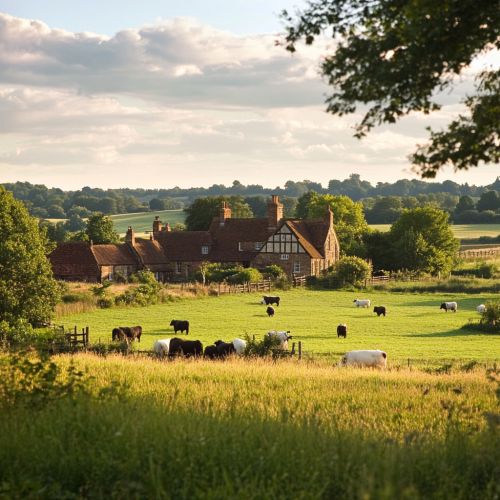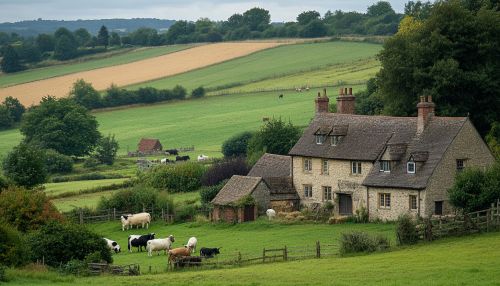Yeomen: Difference between revisions
(Created page with "== Introduction == The term "yeomen" historically refers to a class of people in England who occupied a social position between the gentry and the laboring classes. Yeomen were typically freeholders, owning and cultivating their own land, and they played a significant role in the agricultural economy of medieval and early modern England. Their status and influence varied over time, reflecting broader social and economic changes. == Historical Context == === Origins an...") |
No edit summary |
||
| Line 31: | Line 31: | ||
Yeomen were active participants in their local communities, often taking on leadership roles. They served as members of parish councils, participated in local courts, and contributed to the maintenance of public infrastructure such as roads and bridges. Their involvement in community affairs was both a reflection of their social status and a means of reinforcing it. | Yeomen were active participants in their local communities, often taking on leadership roles. They served as members of parish councils, participated in local courts, and contributed to the maintenance of public infrastructure such as roads and bridges. Their involvement in community affairs was both a reflection of their social status and a means of reinforcing it. | ||
[[Image:Detail-98553.jpg|thumb|center|A traditional English farmstead with fields and livestock, representing a typical yeoman's farm.|class=only_on_mobile]] | |||
[[Image:Detail-98554.jpg|thumb|center|A traditional English farmstead with fields and livestock, representing a typical yeoman's farm.|class=only_on_desktop]] | |||
== Yeomen in Society == | == Yeomen in Society == | ||
Latest revision as of 03:40, 19 October 2024
Introduction
The term "yeomen" historically refers to a class of people in England who occupied a social position between the gentry and the laboring classes. Yeomen were typically freeholders, owning and cultivating their own land, and they played a significant role in the agricultural economy of medieval and early modern England. Their status and influence varied over time, reflecting broader social and economic changes.
Historical Context
Origins and Evolution
The origins of the yeoman class can be traced back to the Middle Ages, a period characterized by feudalism and a rigid social hierarchy. Initially, yeomen were small landowners who held their land directly from the king or a noble lord. Over time, as the feudal system began to decline, yeomen gained more independence and economic power. By the late medieval period, they were recognized as a distinct social class, often described as the backbone of rural England.
Economic Role
Yeomen were primarily engaged in agriculture, cultivating crops and raising livestock on their own land. Their economic activities were crucial to the local and national economy, as they produced food and raw materials for both domestic consumption and export. Unlike tenant farmers, yeomen owned their land outright, which allowed them greater control over their agricultural practices and economic decisions. This ownership also provided them with a degree of social stability and influence within their communities.
Social Status
The social status of yeomen was complex and varied regionally. In some areas, they were considered part of the lower gentry, while in others, they were seen as prosperous peasants. Their status was often linked to the size and productivity of their landholdings, as well as their ability to participate in local governance and community affairs. Yeomen were often involved in local administration, serving as jurors, constables, and churchwardens, which further enhanced their social standing.
Characteristics of Yeomen
Land Ownership
Land ownership was a defining characteristic of the yeoman class. Unlike serfs or tenant farmers, yeomen held freehold land, meaning they owned it outright and had the right to sell or bequeath it. This ownership provided them with economic security and a measure of independence. The size of a yeoman's landholding varied, but it was typically larger than that of a peasant but smaller than that of a noble.
Agricultural Practices
Yeomen were known for their innovative and efficient agricultural practices. They often employed advanced techniques such as crop rotation and selective breeding to maximize productivity. Their farms were typically diversified, with a mix of arable and pastoral land, allowing them to produce a variety of crops and livestock. This diversification helped to mitigate the risks associated with agricultural production and market fluctuations.
Community Involvement
Yeomen were active participants in their local communities, often taking on leadership roles. They served as members of parish councils, participated in local courts, and contributed to the maintenance of public infrastructure such as roads and bridges. Their involvement in community affairs was both a reflection of their social status and a means of reinforcing it.


Yeomen in Society
Political Influence
Yeomen played a significant role in the political life of early modern England. As freeholders, they were eligible to vote in parliamentary elections, giving them a voice in national politics. Their support was often courted by political leaders, particularly during times of social unrest or economic change. The yeomanry was seen as a stabilizing force, with their economic independence and vested interest in maintaining social order.
Military Contributions
Historically, yeomen were also known for their military contributions. They were often called upon to serve as archers or infantrymen in the king's army. The Yeomanry, a volunteer cavalry force established in the late 18th century, drew its name and inspiration from this tradition. Yeomen's military service was both a duty and a source of pride, reinforcing their status as defenders of the realm.
Cultural Depictions
The image of the yeoman has been romanticized in literature and popular culture. They are often depicted as honest, hardworking, and self-reliant individuals, embodying the virtues of rural life. This idealized portrayal can be seen in works such as Chaucer's "The Canterbury Tales" and Shakespeare's plays, where yeomen characters are portrayed as loyal and trustworthy.
Decline and Legacy
Economic Changes
The decline of the yeoman class began in the late 17th and 18th centuries, as economic and social changes transformed rural England. The Agricultural Revolution brought about new farming techniques and increased productivity, but it also led to the consolidation of landholdings and the rise of large-scale commercial farming. Many yeomen were unable to compete with these changes and were forced to sell their land, leading to a decline in their numbers.
Social Mobility
As the traditional agrarian economy gave way to industrialization, opportunities for social mobility increased. Some yeomen were able to adapt to the changing economic landscape by investing in new industries or moving to urban areas. Others, however, were unable to maintain their status and fell into the ranks of the rural poor. Despite this decline, the legacy of the yeoman class persisted, influencing the development of the modern middle class.
Cultural Impact
The cultural impact of the yeomen can still be seen today in the enduring image of the independent farmer and the values associated with rural life. The concept of the yeoman farmer has been particularly influential in the United States, where it was embraced by figures such as Thomas Jefferson as a model for the ideal citizen. This legacy continues to shape contemporary discussions about land ownership, agriculture, and rural identity.
